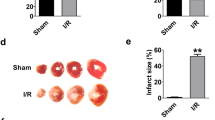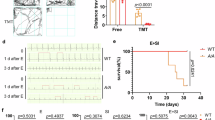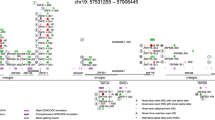Abstract
Activation of p53-dependent apoptosis is critical for tumor suppression but aberrant activation of p53 also leads to developmental defects and heart failure. Here, we found that Rbm24 RNA-binding protein, a target of p53, regulates p53 mRNA translation. Mechanistically, we found that through binding to p53 mRNA and interaction with translation initiation factor eIF4E, Rbm24 prevents eIF4E from binding to p53 mRNA and inhibits the assembly of translation initiation complex. Importantly, we showed that mice deficient in Rbm24 die in utero due to the endocardial cushion defect in the heart at least in part due to aberrant activation of p53-dependent apoptosis. We also showed that the heart developmental defect in Rbm24-null mice can be partially rescued by p53 deficiency through decreased apoptosis in the heart. Together, we postulate that the p53-Rbm24 loop is critical for the heart development and may be explored for mitigating congenital heart diseases and heart failure.
Similar content being viewed by others
Log in or create a free account to read this content
Gain free access to this article, as well as selected content from this journal and more on nature.com
or
References
Levine AJ, Oren M. The first 30 years ofp53: growing ever more complex. Nat Rev Cancer. 2009;9:749–58.
Vousden KH, Prives C. Blinded by the light: the growing complexity of p53. Cell. 2009;137:413–31.
Choi J, Donehower LA. p53 in embryonic development: maintaining a fine balance. Cell Mol Life Sci. 1999;55:38–47.
Grier JD, Xiong S, Elizondo-Fraire AC, Parant JM, Lozano G. Tissue-specific differences of p53 inhibition by Mdm2 and Mdm4. Mol Cell Biol. 2006;26:192–8.
Van Nostrand JL, Brady CA, Jung H, Fuentes DR, Kozak MM, Johnson TM, et al Inappropriate p53 activation during development induces features of CHARGE syndrome. Nature. 2014;514:228–32.
Zhang Q, He X, Chen L, Zhang C, Gao X, Yang Z, et al Synergistic regulation of p53 by Mdm2 and Mdm4 is critical in cardiac endocardial cushion morphogenesis during heart development. J Pathol. 2012;228:416–28.
Jiang Y, Zhang M, Qian Y, Xu E, Zhang J, Chen X. Rbm24, an RNA-binding protein and a target ofp53, regulates p21 expression via mRNA stability. J Biol Chem. 2014;289:3164–75.
Shu L, Yan W, Chen X. RNPC1, an RNA-binding protein and a target of the p53 family, is required for maintaining the stability of the basal and stress-induced p21 transcript. Genes Dev.2006;20:2961–72
Xu E, Zhang J, Zhang M, Jiang Y, Cho SJ, Chen X. RNA-binding protein RBM24 regulates p63 expression via mRNA stability. Mol Cancer Res. 2014;12:359–69.
Zhang J, Jun Cho S, Chen X. RNPC1, an RNA-binding protein and a target of the p53 family, regulates p63 expression through mRNA stability. Proc Natl Acad Sci USA.2010;107:9614–9
Zhang J, Cho SJ, Shu L, Yan W, Guerrero T, Kent M, et al Translational repression of p53 by RNPC1, a p53 target overexpressed in lymphomas. Genes Dev. 2011;25:1528–43.
Zhang J, Xu E, Ren C, Yan W, Zhang M, Chen M, et al Mice deficient in Rbm38, a target of the p53 family, are susceptible to accelerated aging and spontaneous tumors. Proc Natl Acad Sci USA. 2014;111:18637–42.
Poon KL, Tan KT, Wei YY, Ng CP, Colman A, Korzh V, et al RNA-binding protein RBM24 is required for sarcomere assembly and heart contractility. Cardiovasc Res. 2012;94:418–27.
Yang J, Hung LH, Licht T, Kostin S, Looso M, Khrameeva E, et al RBM24 is a major regulator of muscle-specific alternative splicing. Dev Cell. 2014;31:87–99.
Ray PS, Grover R, Das S. Two internal ribosome entry sites mediate the translation of p53 isoforms. EMBO Rep. 2006;7:404–10.
Vagner S, Galy B, Pyronnet S. Irresistible IRES. Attracting the translation machinery to internal ribosome entry sites. EMBO Rep. 2001;2:893–8.
Fisher SA, Langille BL, Srivastava D. Apoptosis during cardiovascular development. Circ Res. 2000;87:856–64.
Gaussin V, Van de Putte T, Mishina Y, Hanks MC, Zwijsen A, Huylebroeck D, et al Endocardial cushion and myocardial defects after cardiac myocyte-specific conditional deletion of the bone morphogenetic protein receptor ALK3. Proc Natl Acad Sci USA 2002;99:2878–83.
James TN. Apoptosis in congenital heart disease. Coron Artery Dis. 1997;8:599–616.
Poelmann RE, Gittenberger-de Groot AC. Apoptosis as an instrument in cardiovascular development. Birth Defects Res. 2005;75:305–13.
Liu P, Xu B, Cavalieri TA, Hock CE. Pifithrin-alpha attenuates p53-mediated apoptosis and improves cardiac function in response to myocardial ischemia/reperfusion in aged rats. Shock. 2006;26:608–14.
Liu Q, Wang G, Zhou G, Tan Y, Wang X, Wei W, et al Angiotensin II-induced p53-dependent cardiac apoptotic cell death: its prevention by metallothionein. Toxicol Lett. 2009;191:314–20.
Kang PM, Izumo S. Apoptosis and heart failure: a critical review of the literature. Circ Res. 2000;86:1107–13.
Kang PM, Izumo S. Apoptosis in heart failure: is there light at the end of the tunnel (TUNEL)? J Card Fail. 2000;6:43–46.
Jeffers JR, Parganas E, Lee Y, Yang C, Wang J, Brennan J, et al Puma is an essential mediator of p53-dependent and -independent apoptotic pathways. Cancer Cell. 2003;4:321–8.
Nakano K, Vousden KH. PUMA a novel proapoptotic gene, is induced by p53. Mol Cell. 2001;7:683–94.
Yu J, Zhang L, Hwang PM, Kinzler KW, Vogelstein B. PUMA induces the rapid apoptosis of colorectal cancer cells. Mol Cell. 2001;7:673–82.
Dor Y, Camenisch TD, Itin A, Fishman GI, McDonald JA, Carmeliet P, et al A novel role for VEGF in endocardial cushion formation and its potential contribution to congenital heart defects. Development. 2001;128:1531–8.
Birks EJ, Latif N, Enesa K, Folkvang T, Luong le A, Sarathchandra P, et al Elevated p53 expression is associated with dysregulation of the ubiquitin-proteasome system in dilated cardiomyopathy. Cardiovasc Res. 2008;79:472–80.
Gill C, Mestril R, Samali A. Losing heart: the role of apoptosis in heart disease--a novel therapeutic target? FASEB J. 2002;16:135–46.
Rezvani M, Barrans JD, Dai KS, Liew CC. Apoptosis-related genes expressed in cardiovascular development and disease: an EST approach. Cardiovasc Res. 2000;45:621–9.
Sano M, Minamino T, Toko H, Miyauchi H, Orimo M, Qin Y, et al p53-induced inhibition of Hif-1 causes cardiac dysfunction during pressure overload. Nature. 2007;446:444–8.
Tsipis A, Athanassiadou AM, Athanassiadou P, Kavantzas N, Agrogiannis G, Patsouris E. Apoptosis-related factorsp53, bcl-2 and the defects of force transmission in dilated cardiomyopathy. Pathol Res Pract. 2010;206:625–30.
Sajjad A, Novoyatleva T, Vergarajauregui S, Troidl C, Schermuly RT, Tucker HO, et al Lysine methyltransferase Smyd2 suppresses p53-dependent cardiomyocyte apoptosis. Biochim Biophys Acta. 2014;1843:2556–62.
Shukla PC, Singh KK, Quan A, Al-Omran M, Teoh H, Lovren F, et al BRCA1 is an essential regulator of heart function and survival following myocardial infarction. Nat Commun. 2011;2:593.
Xiong S, Van Pelt CS, Elizondo-Fraire AC, Fernandez-Garcia B, Lozano G. Loss of Mdm4 results in p53-dependent dilated cardiomyopathy. Circulation. 2007;115:2925–30.
Caprio C, Baldini A. p53 suppression partially rescues the mutant phenotype in mouse models of DiGeorge syndrome. Proc Natl Acad Sci USA. 2014;111:13385–90.
Altin SE, Schulze PC. p53-upregulated modulator of apoptosis (PUMA): a novel proapoptotic molecule in the failing heart. Circulation. 2011;124:7–8.
Li Y, Lv Z, Liu X, Su W, Wang C, Li N, et al Hypoxic postconditioning inhibits endoplasmic reticulum stress-mediated cardiomyocyte apoptosis by targeting PUMA. Shock. 2013;39:299–303.
Mandl A, Huong Pham L, Toth K, Zambetti G, Erhardt P. Puma deletion delays cardiac dysfunction in murine heart failure models through attenuation of apoptosis. Circulation. 2011;124:31–39.
Nickson P, Toth A, Erhardt P. PUMA is critical for neonatal cardiomyocyte apoptosis induced by endoplasmic reticulum stress. Cardiovasc Res. 2007;73:48–56.
Toth A, Jeffers JR, Nickson P, Min JY, Morgan JP, Zambetti GP, et al Targeted deletion of Puma attenuates cardiomyocyte death and improves cardiac function during ischemia-reperfusion. Am J Physiol Heart Circ Physiol. 2006;291:H52–60.
Zhang, Y, Qian, Y, Zhang, J, Yan, W, Jung, YS, Chen, M et al. Ferredoxin reductase is critical for p53-dependent tumor suppression via iron regulatory protein 2. Genes Dev. 2017; 31: 1243-1256.
Scoumanne A, Cho SJ, Zhang J, Chen X. The cyclin-dependent kinase inhibitor p21 is regulated by RNA-binding protein PCBP4 via mRNA stability. Nucleic Acids Res. 2011;39:213–24.
Zhang J, Chen X. DeltaNp73 modulates nerve growth factor-mediated neuronal differentiation through repression of TrkA. Mol Cell Biol. 2007;27:3868–80.
Bonifacino, JS Metabolic labeling with amino acids. Curr Protoc Protein Sci. 2001; Chapter 3: Unit 3 7.
Peritz T, Zeng F, Kannanayakal TJ, Kilk K, Eiriksdottir E, Langel U, et al Immunoprecipitation of mRNA-protein complexes. Nat Protoc. 2006;1:577–80.
Zhang M, Zhang J, Chen X, Cho SJ, Chen X. Glycogen synthase kinase 3 promotes p53 mRNA translation via phosphorylation of RNPC1. Genes Dev. 2013;27:2246–58.
Acknowledgments
This work is supported in part by NIH grants CA076069.
Authors’ contribution
Zhang M., Zhang Y., Xu E., Mohibi S., Jiang Y., de Anda D.M., and Zhang J. did the experiments; Zhang M., Zhang Y., Zhang J., and Chen X. analyzed the data and wrote the manuscript. All authors read and approved the manuscript.
Author information
Authors and Affiliations
Corresponding author
Ethics declarations
Competing interest
The authors declare that they have no competing financial interest.
Additional information
Edited by M. Oren
Electronic supplementary material
Rights and permissions
About this article
Cite this article
Zhang, M., Zhang, Y., Xu, E. et al. Rbm24, a target of p53, is necessary for proper expression of p53 and heart development. Cell Death Differ 25, 1118–1130 (2018). https://doi.org/10.1038/s41418-017-0029-8
Received:
Revised:
Accepted:
Published:
Issue date:
DOI: https://doi.org/10.1038/s41418-017-0029-8
This article is cited by
-
RBM24 regulates apoptosis rates by modulating global transcriptome profile in CAL27 cells
Scientific Reports (2025)
-
Rbm24-mediated post-transcriptional regulation of skeletal and cardiac muscle development, function and regeneration
Journal of Muscle Research and Cell Motility (2025)
-
RNA-binding proteins in cardiovascular biology and disease: the beat goes on
Nature Reviews Cardiology (2024)
-
Dysregulated RBM24 phosphorylation impairs APOE translation underlying psychological stress-induced cardiovascular disease
Nature Communications (2024)
-
Mammalian eIF4E2-GSK3β maintains basal phosphorylation of p53 to resist senescence under hypoxia
Cell Death & Disease (2022)



